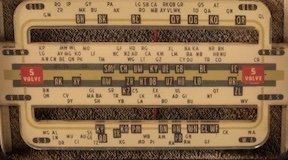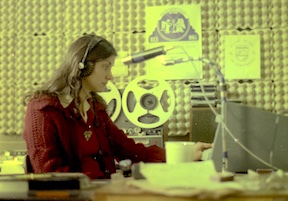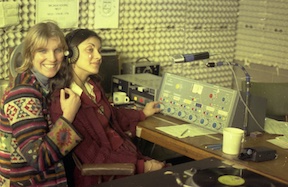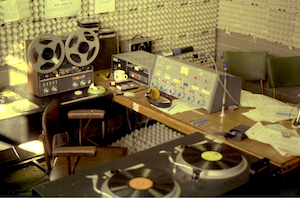Tim Robinson
| Home Tim Robinson Tim History Art Media Services Films Video Information Requests |
3OZZ-FM
The story Behind Student Radio 3-OZZ-FM
Background
In the late 1960’s to early 1970’s, there was a big
political push to open up the FM band following years of
conservative government. The media ownership was in
control of just a few people [Rupert Murdoch Kerry Packer
etc], and there was a vested interest in keeping any one
else that could be seen as competition from getting on the
air waves. The thought that ordinary people might just be
able to run their own broadcast radio station was too much
to bare! Fancy allowing the public to have access to their
own content on the airwaves!
 |
| An Astor "Mickey" c1950's |
Radio dials from that early era of the 1920’s to 1960’s
reflect the fact that you could hard print a dial for a
radio with all the stations in Australia, and not have any
fear of it becoming outdated. No new commercial licenses
were issued in Australia for many years before WW2, and
well after that.
Some people may have heard about the ‘rogue’ transmitter
that was transmitting a signal from the campus of The
University of Melbourne during the early 1970’s. This
caused much consternation at the time as there was still a
large lobby [Murdoch/Packer] which was trying to stop any
form of additional radio stations [commercial or public]
from getting a radio license. The rogue transmitter was
seen as a challenge to the status quo and had to be
silenced. It was more about what it represented than the
actual transmitter itself. Federal police were called to
find the transmitter
and silence it. The Radio licensing branch was pressed in
to service jamming the pirate radio signal. Try as they
may, the transmitter was never found, but the police
raided the Melbourne University radio club and took a
Yaesu FTdx-400 [an amateur band radio transmitter and
receiver - Quite legal!] as a consolation prize. This of
course was NOT on the air at the time and the radio club
had nothing to do with the illegal transmission [it was in
the AM broadcast band]. The police had needed something to
justify their raid, and It took some years for the radio
club to get the FTdx-400 back from the police.
I’m not sure if anyone actually listened to this rogue
transmission - it was more about public access to the
airwaves, and the tight control of what radio licenses
were available at the time. There was a desperate need for
more diversity in broadcasting and this was part of
the start of a push to open up the airwaves and provide
access for other groups to be able to connect with their
own particular content.
1976 - Parkville Campus Radio - 3OZZ-FM
I participated in one of the first test FM broadcasts in Melbourne with a consortium set up through the University of Melbourne. "Parkville Campus Radio" - 3OZZ-FM [92.1Mhz] had an experimental license to broadcast for three days in August 1976 and the studio was located in the Union building. I designed and built the studio around a Phillips broadcast mixer, some turntables and two reel to reel tape recorders. While some of the on-air presentations were rather dubious, the studio held up for the duration with no technical problems [sigh of relief!].
| Setting up the studio for 3OZZ-FM test broadcast and Testing the Equipment |
  |
I was appointed technical manager in early 1976 for a
test broadcast for radio 3OZZ-FM at The University of
Melbourne. I was also on the organising committee. This
test transmission was a pre-cursor for an application for
a public/educational license for a radio station in the FM
Band [88-108 Mhz]. The transmission frequency was 92.1 Mhz
[in glorious mono!]. A consortium had been created between
the Melbourne State College Student Union [formerly
Melbourne Teachers College] and The University of
Melbourne Student Union. My primary involvement was
getting the station on air. This involved wiring up and
testing the studio equipment, and connecting it all
together. The station equipment consisted of a Phillips
broadcast mixing panel, 2 x Revox A77 ¼ inch tape
recorders, a cartridge [tape loop] machine and two
turntables. Parkville Campus Radio ran for three days -
August 4th, 5th and 6th 1976.
This was all done under the auspices of “Parkville Campus
Radio”. The test transmission went to air on August 4th,
5th and 6th [Wednesday to Friday] 1976. It was decided to
broadcast during the week as opposed to a weekend as
students would be on campus at the time and help was
available to assist people wanting to listen [ie; find the
right place on
the dial!]. “Off Air” receivers [cheap $5 transistor AM/FM
radios] were purchased by the student union to provide
access for listeners without an FM receiver. They were
initially sold at cost to anyone who wanted one. Some
ended up being given away to interested people, and those
who might be able to assist with publicity for the event.
Keep in mind that the FM band had yet to be developed, and
up until this time there was only ONE FM broadcast license
issued in Victoria. This was to 3MBS-FM,
a classical music station. At the time most of the general
public were unaware of the FM band as such and had to be
shown how to find stations within this frequency band.
 |
 |
 |
| Nadia on air |
Avril [Left] and
Nadia |
The 3OZZ-FM Studio |
Two of the on air presenters were Nadia Anderson and Avril Bell. Nadia went on to be a presenter at 3 Triple R FM in Melbourne. Nadia and Avril were also on the organising committee which oversaw the setting up and running of the test transmission event and coordination with the University of Melbourne Student Union.
A 10watt FM transmitter and ¼ wave ground plane antenna
were loaned to us by 2MBS
in Sydney. The antenna was installed on the top of the
Raymond Priestly Building [Roughly in the middle of The
University of Melbourne Parkville Campus]. The transmitter
was housed in the lift machinery room at the top of the
building with the aerial cable going to the roof outside.
A temporary broadcast studio was set up in the student
union building, which was next door to the Raymond
Priestly building.
I was on the organising committee. Liberal minister for communications [Guilfoyle] at the time had a daughter at Melbourne University - a conduit to the minister. It was thought it may assist with getting application approved]. However the Government changed and needed to wait until a call for applications for new licenses by the Whitlam government. The broadcast was quite successful, with signal reports coming in from all over Melbourne. A number of programs had been prepared especially for the occasion with different on air presenters.
The government had changed and we needed to wait until a call for applications for new [educational] licenses was made. A consortium formed between [then] Melbourne State College, the Royal Melbourne Institute of Technology [RMIT] and The University of Melbourne. RMIT already had a ‘closed circuit’ radio station that broadcast via speakers around the RMIT campus. After a while an educational licence was issued [3RMT-FM], which eventually became 3RRR-FM.
There was also an organisation set up to coordinate
applications for licenses and assist people with
applications called the PBAA - The Public Broadcasting
Association of Australia, [Now the CBAA -
Community Broadcasting Association of Australia]. Meetings
were held in Canberra and delegates were appointed to
represent the various organisations that were considering
application for a community license or looking for
guidance as to how to go about what was quite a complex
process at the time. There was also a technical committee
[which I was on], which looked at the requirements for
broadcast transmission, and make comments on government
policy in this area. We also discussed the ‘Common
Carrier’ concept in relation to Telecom [now Telstra], the
'common carrier' at the time, and whether that was a good
idea. Telecom had a stranglehold on broadcast
communications but eventually Optus came about partly to
try and provide more competition in regards to public
access to technical infrastructure and the internet.
For further information, see the "My Radio
Life" article for OTN magazine which goes in to much
more detail about this event [downloadable PDF file].
[ Top
of Page | Tim
Robinson | Art
Media Services |
Cooking | Film
and Video]
|
| Published by
Art Media Services Last Updated: February 2025 |